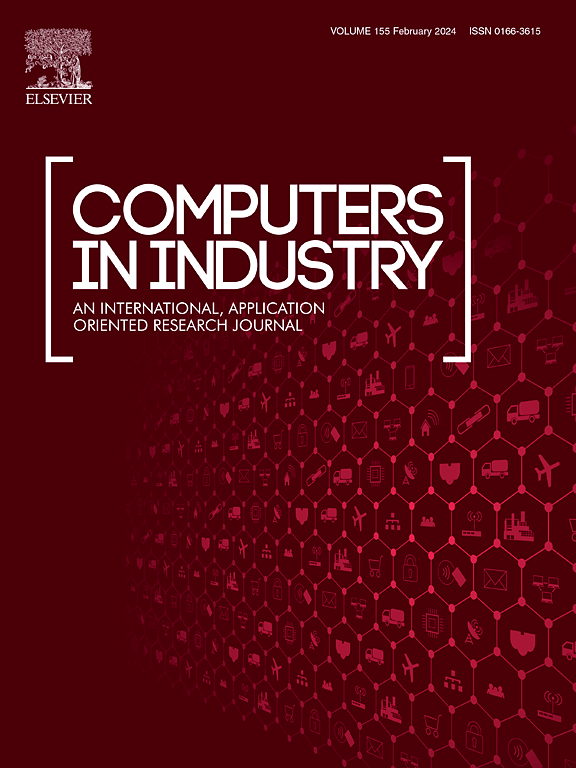利用设备协议匹配模型提高设备访问效率
IF 8.2
1区 计算机科学
Q1 COMPUTER SCIENCE, INTERDISCIPLINARY APPLICATIONS
引用次数: 0
摘要
工业物联网(IIoT)中设备和系统的连接实现了工业系统之间的互操作性和协作。设备接入是实现连接的途径,而协议匹配则是设备接入的基础。由于设备类型多样、协议繁多、与协议私有化相关的问题以及对领域知识的依赖,协议匹配是一项复杂的任务。这些复杂性导致设备访问效率低下。为了提高设备访问效率,本文提出了一种设备协议匹配模型(Device Protocol Matching Model,DPMM),它只使用设备的基本信息(包括协议标识和基本数据)来寻找最佳匹配协议。DPMM 采用两阶段策略,包括本体创建阶段和协议匹配阶段。在本体创建阶段,建立一个简化的设备本体,以便统一表达设备信息和领域知识。在协议匹配阶段,设计了一个基于双层合作迭代(TCI)算法的协议匹配器,以找到最佳匹配协议。在 TCI 中,为了实现协议匹配效率的全局优化,设计了基于惩罚机制的权重更新方法和基于学习的匹配器进化。为了验证 DPMM 的有效性,我们在通信基站和铜冶炼生产线两个场景中进行了实验。实验结果表明,DPMM 可以实现自动协议匹配,平均匹配指数为 80.3%,平均命中率为 35.1%。此外,与现有方法相比,它大大减少了网络资源消耗,最高达 96.7%,命中率最高提高了 12.1 倍。本文章由计算机程序翻译,如有差异,请以英文原文为准。
Improving device access efficiency using a device protocol matching model
The connectivity of devices and systems in the Industrial Internet of Things (IIoT) enables interoperability and collaboration between industrial systems. Device access is the pathway to achieve connectivity, while protocol matching is the basis for device access. Protocol matching is a complex task due to the diverse range of device types, numerous protocols, the issues related to protocol privatization, and the reliance on domain knowledge. These complexities result in inefficient device access. To improve the device access efficiency, a Device Protocol Matching Model (DPMM) is proposed in this paper, which uses only the basic device information to find the best-matched protocol, including protocol identification and basic data. The DPMM adopts a two-stage strategy, consisting of an ontology creation stage and a protocol matching stage. In the ontology creation stage, a simplified device ontology is built to enable the uniform expression of device information and the representation of domain knowledge. In the protocol matching stage, a protocol matcher based on the Two-layer Cooperative Iteration (TCI) algorithm is designed to find the best-matched protocol. In the TCI, to achieve the global optimization of protocol matching efficiency, a penalty mechanism-based weight update method and learning-based matcher evolution are designed. Experiments in two scenarios: a communication base station and a copper smelting production line, are conducted to validate the effectiveness of the DPMM. The experimental results demonstrate that the DPMM can achieve automatic protocol matching with an average matching index of 80.3% and an average hit rate of 35.1%. Moreover, it significantly reduces network resource consumption by up to 96.7%, and increases the hit rate by up to 12.1 times compared with the existing methods.
求助全文
通过发布文献求助,成功后即可免费获取论文全文。
去求助
来源期刊

Computers in Industry
工程技术-计算机:跨学科应用
CiteScore
18.90
自引率
8.00%
发文量
152
审稿时长
22 days
期刊介绍:
The objective of Computers in Industry is to present original, high-quality, application-oriented research papers that:
• Illuminate emerging trends and possibilities in the utilization of Information and Communication Technology in industry;
• Establish connections or integrations across various technology domains within the expansive realm of computer applications for industry;
• Foster connections or integrations across diverse application areas of ICT in industry.
 求助内容:
求助内容: 应助结果提醒方式:
应助结果提醒方式:


